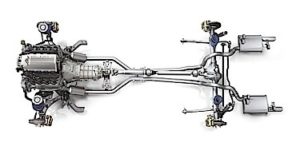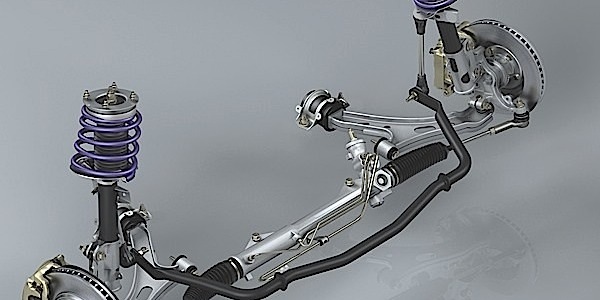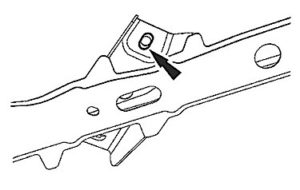
In 2005, Ford introduced a new Mustang with an all-new platform and clean-sheet design. While the formula of a live axle rear and MacPherson strut front end were the same from the previous SN95 and Fox body, Ford refined the design for larger rims by making the bushings larger. These changes made for a vehicle that is easier to align and diagnose compared to the previous generation.
Rear Suspension
The Mustang uses a live rear axle mounted on the vehicle with three links and a Panhard rod. None of the angles are adjustable, but this does not mean that this is a “two wheel” alignment. The thrust angle is critical to aligning the front suspension. Also, it is an indication of the health of the bushings in the control arms.
If you have a customer that is complaining about shudder or hopping on acceleration, check the hydrobushing on the top of the axle. Also, check the condition of the rear transmission mounts, which can mimic the same symptoms.
Front Control Arms

Mustang makes use of an independent MacPherson-strut
front suspension with reverse “L” lower control arms. On this generation of Mustang, the control and steering arms are designed to deform in the event of contact with a curb or other obstruction. Compare measurements like setback and steering angle side to side if there are any large discrepancies.
The ball joint on these Mustangs is non-serviceable and the entire control arm must be replaced. The ball joint has a deflection limit of 0.3 mm (0.012”). These loaded ball joints can be tested by pulling up and down on the control arm while the suspension is loaded. If you can feel any movement, chances are the joint is worn out.
Always tighten the lower control arm and lower ball joint nuts with the suspension at curb height.
Control Arm Bushings
The front lower control arms also use a “Hydro” or hydraulic rubber bushing in the rear mount. Bushings in the front control arms can change the camber and caster by ± 1.0º or more if they are worn. Visually inspect the bushings, looking for any cracks or separation of the rubber from the shaft and shells.
Drivers may comment they hear a grunt, creak or chirp noise while driving over bumps. This is a sign of a bad lower control arm bushing. This noise is different than a noise caused by a worn sway bar or upper strut mount. Strut mounts and sway bars will make a clicking or popping noise on these Mustangs.
There are aftermarket high-performance bushings for this generation of Mustang. But, the customer may notice more noise and vibration transmitted to the vehicle if installed. For some drivers this is acceptable, but for others it could mean a comeback for your shop.
Upper Strut Mounts
Stock upper strut mounts are non-adjustable, but there are aftermarket strut mounts that are adjustable. Some aftermarket mounts can give an additional ±2.0 of caster or camber. These parts are helpful when aligning vehicles that have been lowered up to 3”.
Camber Adjustment – Front
If camber adjustment is necessary to resolve an alignment issue, slotting the strut at the lower mounting hole and installing a cam bolt is recommended. This should give ±1.75º of adjustability.
Remove the wheel speed sensor bolt and brake line bracket bolt before pulling the strut.
Don’t enlarge the holes any more than indicated by the etchings on the strut mount, and clean and paint the exposed metal. The bolts should be tightened to 200 Nm (148 ft/lbs.) after the adjustment is made.
Caster Front
 To adjust front caster, it is necessary to elongate the mounting holes in the front control arm mounting bracket on the subframe. Do not elongate the holes any more than indicated by the etchings on the subframe. This modification will yield about ±1.0 of caster. Tighten the nuts to 175 Nm (129 ft. lbs.). Adjustable upper strut mounts can be used to give ±2.00 of adjustability. But, this requires modification of the strut tower.
To adjust front caster, it is necessary to elongate the mounting holes in the front control arm mounting bracket on the subframe. Do not elongate the holes any more than indicated by the etchings on the subframe. This modification will yield about ±1.0 of caster. Tighten the nuts to 175 Nm (129 ft. lbs.). Adjustable upper strut mounts can be used to give ±2.00 of adjustability. But, this requires modification of the strut tower.













